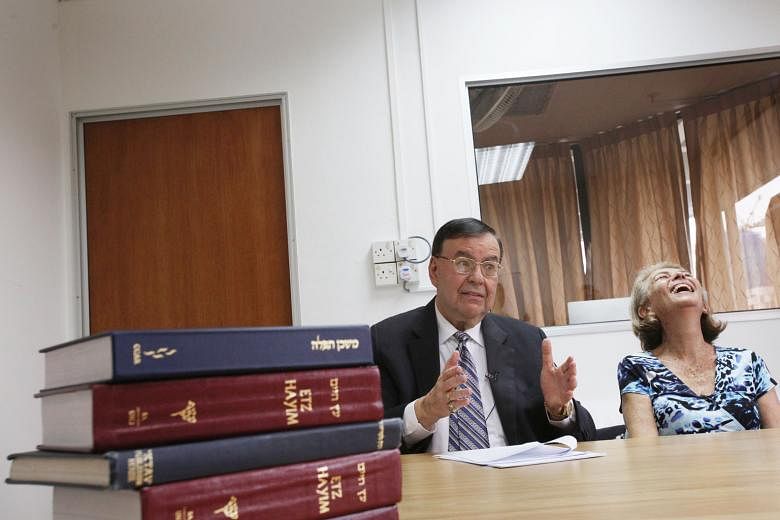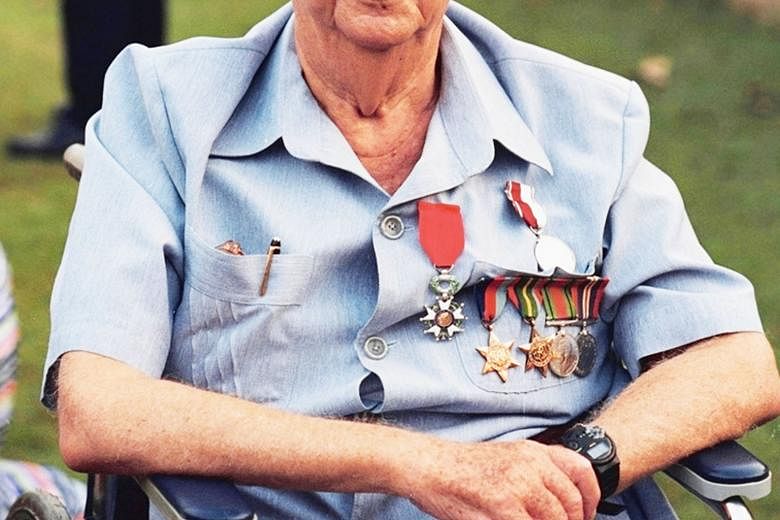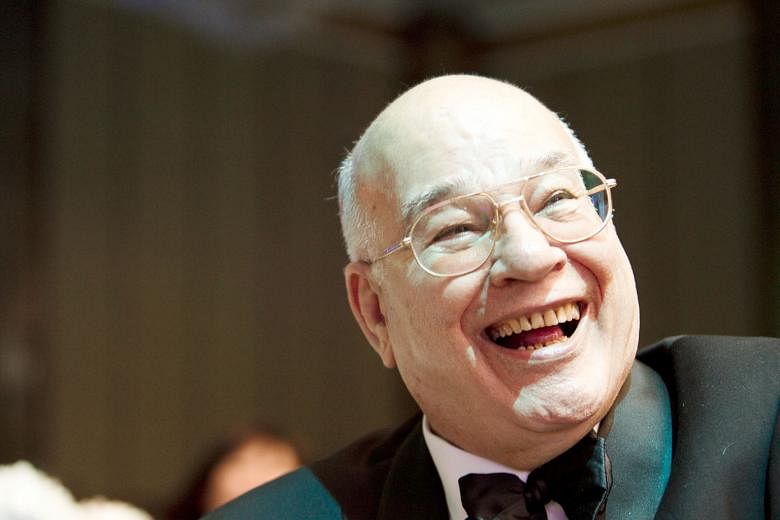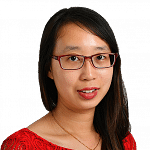When Mr Harvey Goldstein came to Singapore in 1969, the New York native was surprised to find another Yiddish speaker.
"Somebody from an inner room says, 'Eh, Goldstein, come and see here!' I go in, and there is an Israeli working as an adviser," he said, recalling his encounter on an urban planning delegation.
The Indonesia-based consultant, who also works in Singapore, called it a revelation: "Here in Singapore, don't think that Yiddish has to be spoken in a certain area, a certain house, a certain temple."
This is likely even more true today. According to a 2015 estimate, there are around 2,500 Jews here and more than nine in 10 are expatriates from around the world, mostly of Ashkenazi descent.
They bring to the table a smattering of Yiddish - a language similar to German that originated in Eastern Europe in mediaeval times.
In contrast, the Jewish community that settled here in the 19th century comprised mainly Arabic-speaking Mizrahi Jews from Iraq. Its members include the late former chief minister David Marshall and leading lawyer Harry Elias.
Like other ethnic groups here, Jews in Singapore tend to use English in public. What is spoken at home depends on their nationalities - for example, Spanish would be the mother tongue for most Latin American Jews.
Hebrew is the main religious language for all Jews, and is one of Israel's two official languages, alongside Arabic. Used mainly for ritual prayers for centuries, it was successfully revived as a lingua franca in the late 19th century.
The Sir Manasseh Meyer International School - which has a capacity of about 500 students and officially opened here in 2008 after more than a decade as a community learning centre - offers Hebrew as part of Judaic Studies.
But while Hebrew is thriving, Diasporic Jewish languages such as Yiddish are no longer used in daily life.
These languages are dying out not just in Singapore but across the globe as well. The few who still speak them may simply scatter phrases amid regular speech.
-
Jewish languages: Facts and figures
-
ORIGINS
When the Roman Empire destroyed the Second Temple in Jerusalem in the first century, most of the Jewish population went into exile worldwide.
Aramaic and Hebrew were the vernaculars of the day.
Those who lived in Ashkenaz - generally, Germany and Eastern Europe - developed Yiddish in the mediaeval period, from the fifth to 15th century. It is related to German but the alef-beys (alphabet) is based on Hebrew script.
The Jews of Sepharad - Spain and Portugal - were forcibly expelled from their homes in the Iberian peninsula in the late 15th century. They used Ladino, which is based on the Spanish that was spoken at the time of their expulsion.
Many found new homes in the nearby Ottoman Empire, which stretched from Turkey to the Balkans, or moved to the Middle East and North Africa.
NUMBER OF SPEAKERS
About 14.3 million people globally identify religiously as Jewish, which may not include non-practising ethnically Jewish people.
Since the modern revival of Hebrew, it has become one of the official languages of Israel, where about two-fifths of the world's Jewish population reside.
Those living elsewhere now generally speak the lingua franca of their respective countries.
The United Nations Educational, Scientific and Cultural Organisation (Unesco) estimates that there are three million Yiddish speakers worldwide, mostly in the United States and Israel. It lists the language as "definitely endangered".
Ladino is considered by Unesco to be "severely endangered" - a more serious category for languages at risk of dying out - and has about 400,000 speakers globally.
Other historically Jewish languages include Aramaic, believed to have fewer than 50,000 speakers left; Judaeo-Berber, which has around 30,000 speakers; and various dialects of Arabic.
WHERE TO LEARN IT
In Singapore, the Sir Manasseh Meyer International School in Sembawang offers Hebrew through its Judaic Studies programme.
Online Yiddish classes are available through the Hebrew University of Jerusalem - which Albert Einstein visited Singapore in 1922 to raise funds for. Visit http://languages.huji.ac.il for details.
The Workmen's Circle (Der Arbeter Ring), a Jewish-American labour rights and cultural group, also offers online classes. Visit http://circle.org/ for more information.
FOOD
Braided loaves of challah adorn Jewish families' tables on holidays and lox (smoked salmon) bagels are stereotypical Ashkenazi fare.
Jewish cuisine also includes influences from the cultures in the many places Jews have lived - sometimes with adaptations to suit religious dietary laws.
Dishes include:
•Gefilte fish (Ashkenazi), a poached fish cake
•Latkes (Ashkenazi), potato pancakes
•Kufteh (Sephardic), spiced meatballs
•Bunuelos (Sephardic), balls of dough that are stuffed and fried
•Cholent (Ashkenazi) or hamin (Sephardic), stews slow-cooked to comply with the prohibition on cooking during Shabbat (in Yiddish, "Shabbos"), which starts at sunset on Friday
Besides generational language attrition, genocide is part of the story too, said Mr Goldstein.
"Before World War II, we had about 11 million people who were speaking Yiddish. And of the six million who were murdered in the gas chambers, about 85 per cent spoke Yiddish," he said sombrely.
The senior citizen learnt Yiddish from his parents and grandparents, a testament to how the language managed to survive in immigrant communities outside Europe.
It lent copiously to American English, from staples like "klutz", "spiel" and "schmaltzy", to more obscure words like "mishegas" (craziness) and "yenta" (a gossip).
Urban planner Uri Raich, 45, came to Singapore three months ago. His grandparents moved to Mexico in 1929, from what is now Ukraine, Poland and Belarus. In Mexico City, Mr Raich was educated in Yiddish, attending schools with ties to the Bund - a secular socialist movement rooted in Yiddishkayt, or Ashkenazi culture.
"I know how to read and write, but my speaking is gone," he said. "My sense is that Yiddish is unfortunately gone, not only from Singapore but from the world at large (too)." One of his biggest regrets, he said, is that "my kids will never be able to read Bashevis Singer the way I did".
The Polish-born Isaac Bashevis Singer, who wrote in Yiddish, won the Nobel Prize in literature in 1978.
It is hard to find relatively fluent users like Mr Raich here.
Rabbi Nathan Alfred, 37, serves the United Hebrew Congregation, which is affiliated with the Reform movement and has about 200 families. "Although we do have some speakers of either Yiddish or Ladino, it would be an exaggeration to say that there is a critical mass," said Rabbi Alfred, who is originally from Britain.
Another so-called heritage user of the language is Mr Peter Allen, 59, an executive in the travel industry who came to Singapore in 2010.
"I can puzzle out things in Yiddish because of the Hebrew I do know and the German I know," he said. "But I couldn't really read, say, a Yiddish newspaper."
His great-grandparents moved to the United States, changing their names along the way to assimilate better. For example, grandfather Harry was originally Heshl and grand-aunts Rose and Lily had been Reyzl and Luba.
Mr Allen picked up some vocabulary from his mother.
"She would use Yiddish words and phrases with us, and we were expected to understand these expressions... When she would feel affectionate, she didn't call us 'children' but 'kinderlach'." She also emphasised her points with a sharp "Du herst?" (Are you listening?).
Compared with Yiddish, other Jewish languages are even rarer.
Dr Alain Khaiat, 73, may be the only speaker of Tunisian Judaeo-Arabic here. "Most of the Jewish community in Singapore are Iraqi," he said, " so while the older people do speak Arabic, they use a very pure, literary Arabic, which I have difficulties understanding."
Under Ottoman rule, Tunisian Jews were forbidden from speaking Arabic, he said, so they improvised, using a dialect disguised with Hebrew writing and Aramaic vocabulary. But the need for this vanished after the French took over in 1881.
"I don't know if there are more than a handful of people in the world who remember this was a language," said Dr Khaiat, who used it with his grandparents.
The president of the Cosmetic, Toiletry and Fragrance Association of Singapore has lived here since 2006. On one visit to Tunisia, "I used Judaeo-Arabic words and people said, 'Gosh, we haven't heard that in very long.'"
He recalled using "zouz" for the number two, instead of the standard "tnin". It derives from a traditional Passover song in Aramaic, "Chad Gadya" (One Baby Goat), where a man pays two zuzim - an ancient Jewish currency - for the kid.
Meanwhile, lawyer Claudia Kravetz, 37, seeks fellow speakers of Ladino, or Judaeo-Spanish, here. The Chilean has German, Russian and Italian heritage. Italian Jews include Italkim as well as Sephardim.
But Ladino comes by way of her Russian grandfather, who also held a passport from Turkey, which was a bastion of Sephardic Jews given the choice of expulsion, conversion or death in 15th-century Iberia.
Exploring her roots led Ms Kravetz to pick up Ladino by joining a singing group in Santiago.
"In Ladino, there are a lot of songs and proverbs. So for me, also, Ladino is connected to wisdom, because it's the way grandparents and great-grandparents pass knowledge in smart and witty phrases."
For example, "Asno callado, por sabio contado" means "A silent mule is considered wise".
Even if these languages survive only as scraps, remaining speakers associate them with family and community.
"Whenever someone says a Yiddish word to me in kindness, I will be open to further relationships," said Mr Goldstein.
Correction note: This article has been updated for clarity.




